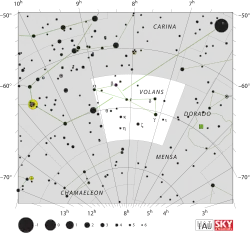Delta Volantis
Delta Volantis, Latinized from δ Volantis, is a solitary[11] star in the southern constellation Volans. It has an apparent visual magnitude of +3.97, which is bright enough to be seen with the naked eye. Based upon parallax measurements, is approximately 740 light years from the Sun.
 | |
| Observation data Epoch J2000.0 Equinox J2000.0 | |
|---|---|
| Constellation | Volans |
| Right ascension | 07h 16m 49.82387s[1] |
| Declination | −67° 57′ 25.7484″[1] |
| Apparent magnitude (V) | 3.97[2] |
| Characteristics | |
| Spectral type | F6 II[3] |
| U−B color index | +0.45[2] |
| B−V color index | +0.78[2] |
| Astrometry | |
| Radial velocity (Rv) | 22.7±0.3[4] km/s |
| Proper motion (μ) | RA: −4.43[1] mas/yr Dec.: +8.38[1] mas/yr |
| Parallax (π) | 4.42 ± 0.11 mas[1] |
| Distance | 740 ± 20 ly (226 ± 6 pc) |
| Absolute magnitude (MV) | −2.80[5] |
| Details | |
| Radius | 24[6] R☉ |
| Luminosity | 1,152[7] L☉ |
| Surface gravity (log g) | 1.77[8] cgs |
| Temperature | 5,386[9] K |
| Metallicity [Fe/H] | 0.110[8] dex |
| Rotational velocity (v sin i) | 5.6±0.3[9] km/s |
| Other designations | |
| Database references | |
| SIMBAD | data |
This is an F-type bright giant star with a stellar classification of F6 II. It has an estimated radius 24 times that of the Sun, and shines with more than a thousand times the Sun's luminosity. The outer atmosphere has an effective temperature of 5,386 K.
References
- van Leeuwen, F. (2007), "Validation of the new Hipparcos reduction", Astronomy and Astrophysics, 474 (2): 653–664, arXiv:0708.1752, Bibcode:2007A&A...474..653V, doi:10.1051/0004-6361:20078357, S2CID 18759600.
- Mermilliod, J.-C. (1986), "Compilation of Eggen's UBV data, transformed to UBV (unpublished)", Catalogue of Eggen's UBV Data. SIMBAD, Bibcode:1986EgUBV........0M.
- Malaroda, S. (August 1975), "Study of the F-type stars. I. MK spectral types", Astronomical Journal, 80: 637–641, Bibcode:1975AJ.....80..637M, doi:10.1086/111786.
- Gontcharov, G. A. (November 2006), "Pulkovo Compilation of Radial Velocities for 35 495 Hipparcos stars in a common system", Astronomy Letters, 32 (11): 759–771, arXiv:1606.08053, Bibcode:2006AstL...32..759G, doi:10.1134/S1063773706110065, S2CID 119231169.
- Anderson, E.; Francis, Ch. (2012), "XHIP: An extended hipparcos compilation", Astronomy Letters, 38 (5): 331, arXiv:1108.4971, Bibcode:2012AstL...38..331A, doi:10.1134/S1063773712050015, S2CID 119257644.
- Pasinetti Fracassini, L. E.; et al. (2001), "Catalogue of Apparent Diameters and Absolute Radii of Stars (CADARS) - Third edition - Comments and statistics", Astronomy & Astrophysics, 367 (2): 521–24, arXiv:astro-ph/0012289, Bibcode:2001A&A...367..521P, doi:10.1051/0004-6361:20000451, S2CID 425754.
- McDonald, I.; et al. (2012), "Fundamental Parameters and Infrared Excesses of Hipparcos Stars", Monthly Notices of the Royal Astronomical Society, 427 (1): 343–57, arXiv:1208.2037, Bibcode:2012MNRAS.427..343M, doi:10.1111/j.1365-2966.2012.21873.x, S2CID 118665352.
- Soubiran, C.; et al. (June 2010), "The PASTEL catalogue of stellar parameters", Astronomy and Astrophysics, 515: A111, arXiv:1004.1069, Bibcode:2010A&A...515A.111S, doi:10.1051/0004-6361/201014247, S2CID 118362423.
- Ammler-von Eiff, Matthias; Reiners, Ansgar (June 2012), "New measurements of rotation and differential rotation in A-F stars: are there two populations of differentially rotating stars?", Astronomy & Astrophysics, 542: A116, arXiv:1204.2459, Bibcode:2012A&A...542A.116A, doi:10.1051/0004-6361/201118724, S2CID 53666672.
- "del Vol -- Star", SIMBAD Astronomical Database, Centre de Données astronomiques de Strasbourg, retrieved 2016-09-04.
- Eggleton, P. P.; Tokovinin, A. A. (September 2008), "A catalogue of multiplicity among bright stellar systems", Monthly Notices of the Royal Astronomical Society, 389 (2): 869–879, arXiv:0806.2878, Bibcode:2008MNRAS.389..869E, doi:10.1111/j.1365-2966.2008.13596.x, S2CID 14878976.
This article is issued from Wikipedia. The text is licensed under Creative Commons - Attribution - Sharealike. Additional terms may apply for the media files.